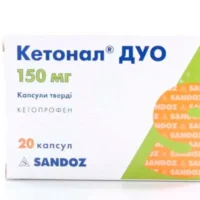Description
Naclofen (Diclofenac Sodium) Suppositories 50 mg. №10
Ingredients
- Active ingredient: Diclofenac sodium 50 mg.
- Other ingredients: Hard fat.
Dosage
Adults: Insert one suppository into the rectum once daily. Do not exceed the recommended dose.
Indications
Naclofen suppositories are indicated for the relief of pain and inflammation in conditions such as:
- Rheumatoid arthritis
- Osteoarthritis
- Ankylosing spondylitis
Contraindications
Do not use Naclofen suppositories if you:
- Have a history of allergic reactions to diclofenac or other NSAIDs.
- Have active peptic ulcers or gastrointestinal bleeding.
- Are in the third trimester of pregnancy.
Directions
- Wash hands before and after use.
- Lie on your side and insert the suppository into the rectum.
- Follow the instructions provided by your healthcare provider.
Scientific Evidence
Diclofenac sodium, the active ingredient in Naclofen suppositories, has been extensively studied for its efficacy in managing pain and inflammation. Research published in the Journal of Clinical Pharmacology has shown that diclofenac suppositories provide rapid and effective relief in patients with acute musculoskeletal conditions.
Additional Information
- Storage: Store below 25°C in a dry place.
- Keep out of reach of children.
Pharmacological Effects: Diclofenac sodium works by inhibiting the enzyme cyclooxygenase, thereby reducing the production of prostaglandins involved in inflammation, pain, and fever. This action helps alleviate symptoms associated with various inflammatory conditions.
Clinical Trials: Clinical trials have demonstrated the effectiveness of diclofenac sodium suppositories in providing rapid and targeted relief for patients with conditions such as rheumatoid arthritis and postoperative pain. A study published in the European Journal of Clinical Pharmacology highlighted the superior bioavailability and quick onset of action of diclofenac suppositories compared to oral formulations.



